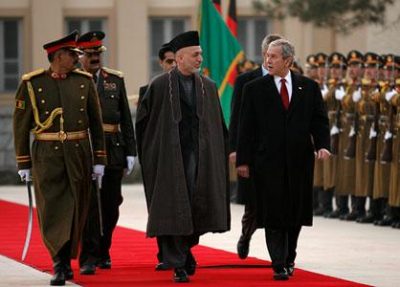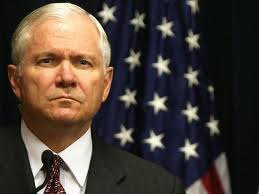20 Years Ago, Prior to 9/11: US Preparations for the Invasion of Afghanistan
The Bush administration was planning its invasion of Afghanistan before the 9/11 attacks

All Global Research articles can be read in 51 languages by activating the “Translate Website” drop down menu on the top banner of our home page (Desktop version).
Visit and follow us on Instagram at @crg_globalresearch.
***
As George W. Bush entered the White House on 20 January 2001, having been granted a controversial election victory, his cabinet swiftly drew up a particularly hawkish foreign policy program. This included identifying a number of strategically important states to gain full ascendancy over, through military attack if needs be, and among the first countries selected for invasion was Afghanistan.
Due to America’s declining oil and natural gas stocks, the top priority for president Bush was to increase US influence over rich fossil fuel sources, constructing pipelines, refineries and other such infrastructure.
Contrary to what numerous mainstream outlets have claimed over the past two decades, the Bush administration was planning its invasion of Afghanistan before the 9/11 attacks on America, which were then used as a pretext for armed intervention. Niaz Naik, Pakistan’s experienced former foreign secretary, has provided testimony on this.
Naik informed the BBC a week after 9/11 how he was told by senior US officials, in mid-July 2001, that Washington was preparing military action against Afghanistan (1). Naik was informed by the Americans that their invasion of Afghanistan would begin, at the latest, in the middle of October 2001, before the first Afghan snow flurries arrived. The US Armed Forces would launch their attack from bases in Tajikistan, the Central Asian country, which borders Afghanistan to the north. US advisers were present in Tajikistan by the summer of 2001.
Consequently, Bush was planning to wage a war in Afghanistan at least 8 weeks prior to the 9/11 atrocities, and indeed most probably longer than that. Naik’s comments are supported by General Hamid Gul, the former head of ISI, Pakistan’s leading intelligence agency. General Gul believed that US plans to engage militarily in Afghanistan “predated 9/11” (2). It is not terribly surprising that he came to such a conclusion. The 9/11 attacks obviously occurred on 11 September 2001, while the US-led invasion of Afghanistan commenced on 7 October 2001 – that is 26 days after 9/11.
It is not possible to prepare and initiate a large-scale military assault in less than 4 weeks, especially against a country on the other side of the world. As any commander would surely admit the planning alone takes months, before the offensive can begin.
 US drones, such as the RQ-1 Predator, were hovering above the Afghan skies before 9/11. These unmanned aerial vehicles (UAVs) were partaking in reconnaissance sorties, and collecting other information about Afghanistan, in preparation for the invasion. A US military operation in Afghanistan was not concerned with either “combating terrorists” or capturing Osama bin Laden, the Al Qaeda chief. President Bush said 5 months after the offensive had begun on 13 March 2002, “I am truly not that concerned about him [Bin Laden]”. The authenticity of this remark was confirmed by White House transcripts. (3)
US drones, such as the RQ-1 Predator, were hovering above the Afghan skies before 9/11. These unmanned aerial vehicles (UAVs) were partaking in reconnaissance sorties, and collecting other information about Afghanistan, in preparation for the invasion. A US military operation in Afghanistan was not concerned with either “combating terrorists” or capturing Osama bin Laden, the Al Qaeda chief. President Bush said 5 months after the offensive had begun on 13 March 2002, “I am truly not that concerned about him [Bin Laden]”. The authenticity of this remark was confirmed by White House transcripts. (3)
As early as December 2001 Bin Laden was not even in Afghanistan. He was instead further south in Pakistan’s tribal regions (4). US General Tommy Franks, the commander overseeing the military operations in Afghanistan, insisted just one month into the invasion on 8 November 2001, “We have not said that Osama bin Laden is a target of this effort”.
The Chairman of the US Joint Chiefs of Staff, General Richard Myers, outlined how “our goal has never been to get Bin Laden”. (5)
 What of Bush’s state of mind? He reportedly informed diplomats at an Israel-Palestine summit in Egypt during June 2003, “I am driven with a mission from God” who the president said had told him “’George, go and fight these terrorists in Afghanistan’” and “’George, go and end the tyranny in Iraq’. And I did” (6). Incredibly, the former CIA director Robert Gates (image left) acknowledged in his memoirs that those in Washington, including himself, had little comprehension of Afghanistan as a country.
What of Bush’s state of mind? He reportedly informed diplomats at an Israel-Palestine summit in Egypt during June 2003, “I am driven with a mission from God” who the president said had told him “’George, go and fight these terrorists in Afghanistan’” and “’George, go and end the tyranny in Iraq’. And I did” (6). Incredibly, the former CIA director Robert Gates (image left) acknowledged in his memoirs that those in Washington, including himself, had little comprehension of Afghanistan as a country.
The Americans didn’t understand its complex tribal make-up, ethnic groups and rivalries. Gates wrote that, “nearly always, we begin military engagements – wars – profoundly ignorant about our adversaries and about the situation on the ground”. (7)
One need only glance at Afghanistan’s position on the map, in south-central Asia, to grasp why Bush’s White House was so interested in that country. Afghanistan is situated close to the oil and gas rich Middle East, while it lies beside the former Soviet republics of Central Asia. This century, it has been discovered that Afghanistan contains millions of tons of lucrative mineral resources, from copper and gold to lithium (8). Afghanistan’s mineral wealth was well known in Washington, as the assessment of its natural resources was conducted in part by the US Geological Survey, a scientific branch of the American government.
 Furthermore, Bush’s neoconservative officials wanted to construct oil and gas pipelines across Afghan terrain, to benefit US energy corporations. Bush is a former Texas oil executive dating to the 1970s, and his presidential campaign in 2000 received large donations from American fossil fuel firms, such as ExxonMobil. This assisted in him winning the White House (9). Vice-president Dick Cheney was, from 1995 to 2000, the chief executive of Halliburton, a noted US energy company. Cheney’s close links to the oil industry would continue for many years.
Furthermore, Bush’s neoconservative officials wanted to construct oil and gas pipelines across Afghan terrain, to benefit US energy corporations. Bush is a former Texas oil executive dating to the 1970s, and his presidential campaign in 2000 received large donations from American fossil fuel firms, such as ExxonMobil. This assisted in him winning the White House (9). Vice-president Dick Cheney was, from 1995 to 2000, the chief executive of Halliburton, a noted US energy company. Cheney’s close links to the oil industry would continue for many years.
Condoleezza Rice, Bush’s National Security Advisor and then Secretary of State, was a director for 10 years at the Chevron Corporation, America’s third biggest oil company and the largest investor in the resource rich Caspian Sea (a body of water located a few hundred miles north-west of Afghanistan). Rice resigned from her position at Chevron on 15 January 2001, and five days later she became the National Security Advisor. Chevron had previously named an oil tanker after her, the “Condoleezza Rice”. (10)
Other Bush officials were centrally involved in the oil business, like the Commerce Secretary Donald Evans, a close friend of the president’s. Worth mentioning too is Zalmay Khalilzad, the Afghan-born American diplomat who Bush relied upon for information on Afghanistan. In the 1990s, the pro-war Khalilzad worked for a time as a consultant to the US oil giant UNOCAL (Union Oil Company of California), which was involved in constructing a Trans-Afghanistan Pipeline, to run from the Caspian Sea through Afghanistan. (11)
Part of the thinking behind the US invasion of Afghanistan, was to allow UNOCAL to build two other oil pipelines: one across Afghanistan through neighbouring Pakistan to the Indian Ocean, while the other – the Central Asia Oil Pipeline Project (CAOPP) – would stretch for 1,050 miles from Chardzhou in Turkmenistan, which borders Afghanistan.
The Brazilian historian Moniz Bandeira wrote of US thinking, “This would prevent Azerbaijani oil from passing through Russia. And this objective was clear” (12). There were also plans to build a gas pipeline, from Uzbekistan through Afghanistan and on to Pakistan. A main factor in US government strategy was to further erode Russian strength, by moving into its previous domains, Central Asia and the Caucasus, with Afghanistan being a pawn in the great game. American control over Central Asia would in addition hamper Chinese power, while a US presence in the region posed a significant threat to arch enemy Iran.
The Americans had, since 1997, been conducting an array of military exercises in Central Asia. Three years before, they had established NATO’s so-called Partnership for Peace Program, with the ex-Soviet republics in mind. Bill Richardson, the Energy Secretary to Bush’s predecessor Bill Clinton, said that the one-time Soviet states were “all about America’s energy security” and “it’s very important to us that the pipeline map and politics come out right”. (13)
Bush was intent on gaining mastery over oil sources outside of the volatile Middle East, which there was no guarantee they could continue relying on. Some estimates in Washington indicated that the US could obtain, from the largely untapped wells of Central Asia, over 80% of America’s entire oil needs by the year 2050. (14)
US planners were focusing increasingly on the major fossil fuel reserves in the Caspian Sea, our planet’s largest landlocked source of water, considerably bigger in size than Britain. In 1998 Cheney, who was then an adviser to the Central Asian countries regarding oil infrastructure, had said, “I cannot think of a time when we had a region emerge as suddenly to become as strategically significant as the Caspian” (15). Its waters flow across the frontiers of Iran, Russia, Kazakhstan, Turkmenistan and Azerbaijan.
The 9/11 attacks provided the White House with a remarkable justification to expand US global hegemony (16). Almost immediately following 9/11, Washington ramped up its military presence in Central Asia. By February 2002, the Americans had established bases in each of the five Central Asian states. This would facilitate US Army operations in nearby Afghanistan. Moreover, the Central Asian country of Turkmenistan contains the 6th largest gas reserves in the world, while Kazakhstan possesses the 12th biggest oil sources on earth and the 10th largest coal deposits.
The US military mission was supposedly to fight a “war on terror” in Afghanistan, for humanitarian purposes. This was, of course, propaganda relayed to the public through a pliant and naive media. It is not feasible to overcome terrorism by force of arms, and this in fact greatly exacerbates the problem; somewhat like smashing a hornet’s nest with a sledgehammer. Far from pursuing a war against terrorism, the US government was attempting to augment its world power and imperial goals, in order for example as Bandeira wrote “to ensure an environment that would make the construction of pipelines by the Union Oil Company of California (UNOCAL) possible, carrying the oil from Uzbekistan to the Indian Ocean”. (17)
UNOCAL would in 2005 be taken over by Chevron, the same corporation where Rice, the National Security Advisor, was formerly a board member. The Bush regime wanted also to assume control over the resource plenty Caucasus, particularly Azerbaijan, as the Third Reich had attempted to do 60 years before. Azerbaijan and Georgia, two former Soviet states, were essential in the transport of heavy American weaponry and NATO troops, which would be bound for Afghanistan not far to the east of Azerbaijan.
Germany’s president Horst Köhler said years later, in an interview over the radio, that German soldiers operating alongside the Americans were stationed abroad “to protect our interests, for example free trade routes” (18). Köhler let slip that the thousands of German troops under the NATO banner, such as in Afghanistan, were not there to fight terrorism after all, but their role was to safeguard Western commercial interests. Köhler was promptly forced to resign the presidency, because his comments were presumably too close to the mark.
Following the Soviet Union’s collapse, NATO has become a worldwide intervention force, still firmly under US auspices. During this time, NATO has executed often brutal military actions such as in Bosnia (from the early 1990s), Yugoslavia (1999), Afghanistan (from 2001) and Libya (2011). Among NATO’s aims are, as its secretary-general Jaap de Hoop Scheffer remarked bluntly in June 2007, “NATO troops have to guard pipelines that transport oil and gas that is directed for the West”; and to protect sea routes used by oil tankers along with other “crucial infrastructure” of the world energy system. So much for NATO’s stated goal of countering “Russian aggression”.
While Bush and company in the first months of 2001 were formulating their invasion of Afghanistan, at about the same time they were starting to sketch plans to overthrow Saddam Hussein in Iraq. Two months into the Bush presidency, in March 2001 vice-president Cheney’s Energy Task Force had already developed maps outlining the oil refineries, pipelines and terminals that the US would construct in Iraq, once they had toppled Saddam through military force. (19)
These plans were beginning about 6 months before 9/11. Saddam was once a valued US ally, and his human rights violations were ignored when he was obeying orders. By early this century, however, Saddam was showing too much independence. The Iraqi dictator had signed contracts with Russia’s energy firm, Lukoil; he was pursuing talks with the French multinational Total, a fossil fuel corporation; while he was substituting the dollar for the euro as the currency for oil transactions. (20)
*
Note to readers: please click the share buttons above or below. Forward this article to your email lists. Crosspost on your blog site, internet forums. etc.
Shane Quinn obtained an honors journalism degree. He is interested in writing primarily on foreign affairs, having been inspired by authors like Noam Chomsky. He is a frequent contributor to Global Research.
Notes
1 BBC News, “US ‘planned attack on Taleban’ [Afghanistan]”, 18 September 2001
2 Luiz Alberto Moniz Bandeira, The Second Cold War: Geopolitics and the Strategic Dimensions of the USA (Springer 1st ed., 23 June 2017) p. 31
3 Ibid., p. 143
4 Arnaud de Borchgrave, “Elvis bin Laden”, Atlantic Council, 27 July 2010
5 Jeremy R. Hammond, “Ex-ISI Chief says Purpose of New Afghan Intelligence Agency RAMA is ‘to destabilize Pakistan’”, Foreign Policy Journal, 12 August 2009
6 Ewen MacAskill, “George Bush: ‘God told me to end the tyranny in Iraq’”, The Guardian, 7 October 2005
7 Robert Gates, Duty: Memoirs of a Secretary at War (Knopf; 14 January 2014) End chapter, Reflections
8 Charles Q. Choi, “Rare Earth: Afghanistan sits on $1 trillion in minerals”, NBC, 5 September 2014
9 Brendan Montague, “George W. Bush elected in 2000 ‘floating on oil money’”, The Ecologist, 5 October 2018
10 Carla Marinucci, “Critics knock naming oil tanker Condoleezza”, SFGate, 5 April 2001
11 Graham Winfrey, “Bush’s oil cronies: Where are they now?”, Business Insider, 25 January 2010
12 Bandeira, The Second Cold War, p. 41
13 John Pilger, The New Rulers Of The World (Verso Books, 20 February 2003) p. 111
14 Bandeira, The Second Cold War, p. 29
15 Pilger, The New Rulers Of The World, p. 110
16 Ibid., p. 109
17 Bandeira, The Second Cold War, p. 45
18 Sebastian Fischer, Veit Medick, “Köhler sparked a new war debate”, Der Spiegel, 27 May 2010
19 Bandeira, The Second Cold War, p. 81
20 Ibid.
Featured image: George W. Bush visits Hamid Karzai, who participated in the Mujahideen in the past and led the puppet government that replaced the Taliban.
by Michel Chossudovsky
- ISBN Number: 9780973714715
- List Price: $24.95
- click here to order
Special Price: $18.00
In this new and expanded edition of Michel Chossudovsky’s 2002 best seller, the author blows away the smokescreen put up by the mainstream media, that 9/11 was an attack on America by “Islamic terrorists”. Through meticulous research, the author uncovers a military-intelligence ploy behind the September 11 attacks, and the cover-up and complicity of key members of the Bush Administration.
The expanded edition, which includes twelve new chapters focuses on the use of 9/11 as a pretext for the invasion and illegal occupation of Iraq, the militarisation of justice and law enforcement and the repeal of democracy.
According to Chossudovsky, the “war on terrorism” is a complete fabrication based on the illusion that one man, Osama bin Laden, outwitted the $40 billion-a-year American intelligence apparatus. The “war on terrorism” is a war of conquest. Globalisation is the final march to the “New World Order”, dominated by Wall Street and the U.S. military-industrial complex.
September 11, 2001 provides a justification for waging a war without borders. Washington’s agenda consists in extending the frontiers of the American Empire to facilitate complete U.S. corporate control, while installing within America the institutions of the Homeland Security State.

